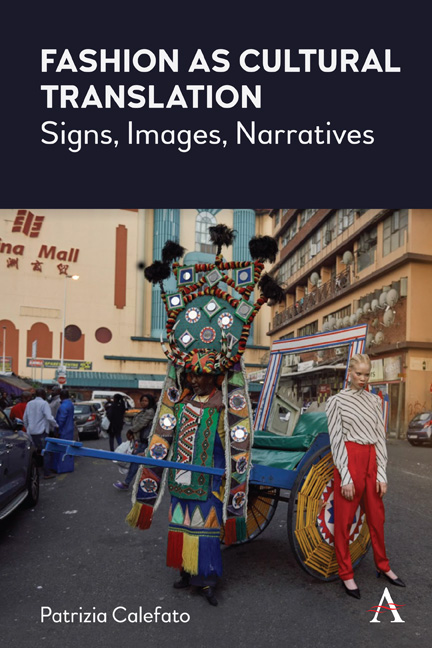Book contents
- Frontmatter
- Contents
- Introduction: Fashion as Cultural Translation in the Hyperconnected World
- Supplement to the Introduction: Fashion, the Hyperconnected World and Coronavirus
- 1 Time
- 2 Spaces
- 3 Fashion as Cultural Tradition: Italian Style
- 4 Fashion as Cultural Translation
- 5 Clothed Bodies
- 6 The Body as Text
- 7 Humans and Beyond
- 8 Fashion and the ‘Second Nature’
- 9 Fashion, Communication and Converging Media
- 10 Fashion Narratives in Visual Culture
- Conclusions: Fashion as an Idea about the Future
- References
- Index
Supplement to the Introduction: Fashion, the Hyperconnected World and Coronavirus
Published online by Cambridge University Press: 18 February 2021
- Frontmatter
- Contents
- Introduction: Fashion as Cultural Translation in the Hyperconnected World
- Supplement to the Introduction: Fashion, the Hyperconnected World and Coronavirus
- 1 Time
- 2 Spaces
- 3 Fashion as Cultural Tradition: Italian Style
- 4 Fashion as Cultural Translation
- 5 Clothed Bodies
- 6 The Body as Text
- 7 Humans and Beyond
- 8 Fashion and the ‘Second Nature’
- 9 Fashion, Communication and Converging Media
- 10 Fashion Narratives in Visual Culture
- Conclusions: Fashion as an Idea about the Future
- References
- Index
Summary
Viral Globalisation
The Coronavirus pandemic, which the world is experiencing at varying phases and intensities as I write, confirms that the contemporary world is a landscape in continuous movement. This landscape is crossed by a variety of global flows (Appadurai 1996), which involve people, images, narratives, goods, messages, digital impulses and infinitely small beings such as viruses. Within weeks, every part of the world has been hit by the epidemic: the virus has travelled around the whole world in ways that are comparable to those of populations, goods and messages. In this case, the speed of movement and communication – which were crucial in the age of global technological interconnection – did not concern only the fluxes of bits and data travelling on telematic networks, but also the physical microscopic body of the virus and, consequently, the physical bodies of the people and the communities that became infected.
In the contemporary lexicon of communication, the metaphor or virality describes how messages navigate in the digital infosphere. A ‘viral’ image, text, meme, video, expression, or any other textual form – preferably short and incisive – can be communicated quickly by many people, and from these people to even more people, exponentially. Virality reproduces itself, it creates variations, it decontextualises and recontextualises the original message. The latter often loses its initial charge – its virulence. It crystallises and remains sedimented in the infosphere either as a forgotten excess, replaced by something new or as an effect-less element because the subjects of communication digested its meanings until they became immune to it. Today, this metaphor has become a literal pun: the virus has become viral. However, as every good metaphor does, this one too still has something to show us. Treating messages and signs like viruses enables us to treat the virus as a message in turn, namely as something which we can subject to human intentionality. In part, this is the task of the life sciences, including biology, epidemiology, medicine, chemistry, immunology, mathematics and the information sciences, which can tell us – and will become increasingly better at telling us – how the virus transmits itself, how it becomes weaker or stronger, if and how it mutates, how we can recover from it and, hopefully, in rapid times, how we can become immune to it.
- Type
- Chapter
- Information
- Fashion as Cultural TranslationSigns, Images, Narratives, pp. xv - xxivPublisher: Anthem PressPrint publication year: 2021

